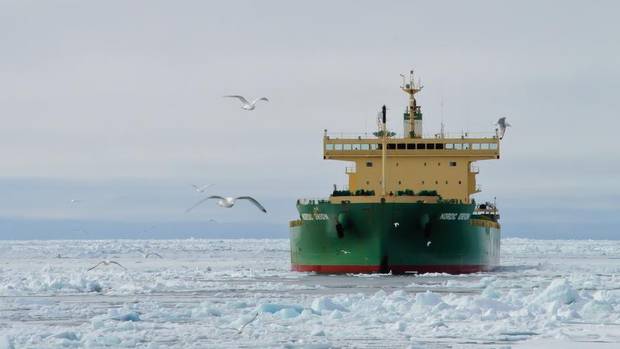The Norwegian ship, Orion, recently embarked on the first commercial journey across the Northwest Passage in over 40 years. Carrying a large cargo of coal from Vancouver, the Orion is scheduled to arrive in Finland in mid-October. Given the recession of Arctic ice over the past decades, such usage of the Northwest Passage may become more common in the future as the passage becomes more reliable. The shipping lane holds much commercial potential, and the Canadian federal government must act swiftly to secure long-term Canadian interests.
[captionpix align=”right” theme=”elegant” width=”300″ imgsrc=”http://natoassociation.ca/wp-content/uploads/2013/09/Orion.jpg” captiontext=”The Orion recently embarked on the first commercial journey across the Northwest Passage in over 40 years.”]
Prior to the 20th century Arctic weather, constantly changing terrain and lack of emergency support made commercial use of the Passage impossible. However, as a result of climate change, Arctic ice has receded dramatically. If the Northwest Passage becomes reliably ice-free, even if only for a few favorable months per year, the geographic location of the passage would make it one of the busiest shipping lanes in the world.
Without the Northwest Passage, ships traveling between the Pacific and Atlantic oceans are currently limited to three options: the Northeast Passage, the Panama Canal and traveling around South America. The Northeast Passage is only open for a few months of the year and demand for its use is comparatively low. While the Panama Canal is in an ideal geographic location, its use is limited to vessels weighing less than 80,000 tones, forcing large cargo ships to travel around South America. Such costly detours would be greatly diminished through use of the North West Passage. In fact, shipping experts estimate that some journeys can be shortened by as many as 7000 kilometers. Access to the Northwest Passage, even if only for a few months every year, will be vital to the international shipping economy and facilitate trade between western North America and European nations.
[captionpix align=”left” theme=”elegant” width=”300″ imgsrc=”http://natoassociation.ca/wp-content/uploads/2013/09/NWpassageMap.gif” captiontext=”The Northwest Passage through the Canadian Arctic Archipelago.”]
Historically, sovereignty over the Northwest Passage has been a critical tenet of Canadian foreign policy. Recent history can be traced to 1969, when US oil tanker Manhattan traversed the Northwest Passage without express permission from the Canadian government, provoking widespread Canadian indignation. In response to the incident, the Trudeau Administration declared functional jurisdiction over the waters between Arctic islands according to the Arctic Waters Pollution Act in 1970. At the time, US President Nixon respected this legislation. Similarly, when Brian Mulroney claimed sovereignty over Arctic territory in 1985, President Reagan acknowledged and respected this claim.
Despite unprecedented economic opportunities, frequent commercial use of the Northwest Passage also threatens Canadian interests and the Arctic environment. Large cargo ships often lack maneuverability, requiring several kilometers just to stop. Arctic waters with constantly changing ice formations may cause accidents. In that event, large oil spills in the Arctic will be exponentially more difficult to clean up given the remoteness of the region and frequent bad weather. In addition, American analysts have expressed concerns that an unsupervised Northwest Passage may grant smugglers, criminal gangs or even terrorists easy access to North America.
The Canadian government can address some of these concerns by upgrading the equipment of the Canadian Coast Guard, improving search and rescue services and funding a fleet of icebreakers. Canada’s Arctic capability is extraordinarily inadequate in several respects. For example, there are no Canadian Coast Guard bases in the Arctic. The few Canadian icebreakers that are still functional are outdated and not large enough to escort commercial vessels. In contrast, Russia operates a large fleet of modern icebreakers to accompany cargo ships. Although the Canadian federal government has started to build new icebreakers, the process is slow.
[captionpix align=”right” theme=”elegant” width=”300″ imgsrc=”http://natoassociation.ca/wp-content/uploads/2013/09/CanadianIcebreaker.jpg” captiontext=”Frederick Pai argues that the Canadian federal government should invest in its Arctic infrastructure.”]
Finally, the lack of deep-water ports in the Arctic Archipelago poses a significant risk to commercial vessels in the event of mechanical failure. Comparatively, Russia operates 16 deep-water ports along their arctic coastline. If the Canadian government is able to create infrastructure and ensure safe usage of the Northwest Passage, shipping firms are more likely to register their vessels with the government of Canada, and by implication, acknowledge Canadian sovereignty over the Passage.
Canada’s sovereignty over its Arctic archipelago will come under greater international scrutiny in the near future. Although the US has recognized Canadian sovereignty over the arctic in the past, many observers suggest that the Northwest Passage is in fact an international strait. The onus is on the federal government to take action before it is too late.




